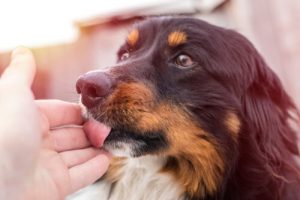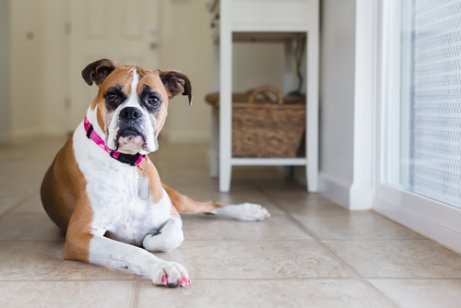What Are the Symptoms and Behavior of Dogs in Heat?

Dogs in heat show typical symptoms and behaviors. Beyond the usual drops of blood that are found on the floor when a dog is in heat, many males as well as females show changes in their behavior.
- How to Recognize Heart Problems in Cats
- How to Recognize Heart Problems in Dogs
- Treatment and Prevention of Stomach Torsion in Dogs
When your pet is getting ready to reproduce, they experience some changes in behavior. You can detect certain physical and emotional symptoms during the period of time when dogs are in heat. Keep reading, and you’ll find out more in this article.
Dogs in Heat: What to Know
Dogs in heat have basic traits. This is a phase that the female starts to ovulate in order to reproduce.
During this time of heat, the female dog will attempt to draw the attention of male dogs in different manners. The hormonal changes interfere with the female dog’s behavior and you’ll notice that something is occurring with your pet long before you see any drops of blood on her bedding.
The first period of heat take place between the sixth and eighth month of life and repeats once or twice a year. This happens in order to guarantee the survival of the species and has been passed down directly from their relatives, the wolves.
There’s no exact time this takes place, even though it happens more frequently at the end of winter and the beginning of spring.
The mating period of dogs can last up to 23 days, but the female isn’t fertile during this entire time. However, it’s important to know that if the dog has been spayed, there are no symptoms of being in heat.

Signs of Dogs in Heat
All female mammals go into heat, they experience several hormonal, physical and emotional changes when they’re in heat. As a result, you can observe a female dog behaving in a different way than usual. In the morning they may act one way and in the afternoon a different way. Some of the symptoms of heat are the following:
1. Being more affectionate
During the first days of heat, your dog will probably be more affectionate than usual. She will stay close to you and will want to be petted continually. Additionally, she may become anxious if you leave her alone for many hours.
2. Swollen sex organs
This is one of the physical signs you’ll notice when a dog enters into heat. The vulva are normally swollen during the first weeks of this period. In some dogs, their private parts also become darker and you’ll notice that they will often lick this area.
3. In search of males
When your dog is in heat, you need to be very watchful over her to prevent any unexpected pregnancies. Take note if she gets closer to males than females during a walk in the street or in the park. Also, when she gets close to a probable mate, he’ll want to play only with her.

4. Bleeding
In addition, if a female dog is in heat you’ll notice drops of blood, identical to women during their menstrual cycle. In this case, bleeding takes place with the inflammation of the vulva in order to call the attention of males.
Dogs are guided by smell. Therefore, they will be guided by the pheromones which a female release to attract possible mates.
5. Changes in diet of dogs in heat
When in heat, some dogs don’t consume their customary diet. Perhaps they are rather lackadaisical and show a bit of reluctance to eat.
What Happens to the Male?
Male dogs don’t go into heat like the females do. However, they do change their behavior when they detect a nearby female as a potential mate.
Males may become more aggressive due to an increase in hormones known as testosterone and cortisol. Also, they’ll be restless, bark a lot, or howl at night. In addition, they may try to escape from the house or mark their territory by urinating everywhere.
At the same time, males can become depressed when they don’t leave the house, feeling somewhat confused or distracted and they may become combative with themselves.
To avoid all these signs in males and females, the best alternative is sterilization. In addition, this has the benefit of preventing packs of dogs from roaming the streets.
Dogs in heat show typical symptoms and behaviors. Beyond the usual drops of blood that are found on the floor when a dog is in heat, many males as well as females show changes in their behavior.
- How to Recognize Heart Problems in Cats
- How to Recognize Heart Problems in Dogs
- Treatment and Prevention of Stomach Torsion in Dogs
When your pet is getting ready to reproduce, they experience some changes in behavior. You can detect certain physical and emotional symptoms during the period of time when dogs are in heat. Keep reading, and you’ll find out more in this article.
Dogs in Heat: What to Know
Dogs in heat have basic traits. This is a phase that the female starts to ovulate in order to reproduce.
During this time of heat, the female dog will attempt to draw the attention of male dogs in different manners. The hormonal changes interfere with the female dog’s behavior and you’ll notice that something is occurring with your pet long before you see any drops of blood on her bedding.
The first period of heat take place between the sixth and eighth month of life and repeats once or twice a year. This happens in order to guarantee the survival of the species and has been passed down directly from their relatives, the wolves.
There’s no exact time this takes place, even though it happens more frequently at the end of winter and the beginning of spring.
The mating period of dogs can last up to 23 days, but the female isn’t fertile during this entire time. However, it’s important to know that if the dog has been spayed, there are no symptoms of being in heat.

Signs of Dogs in Heat
All female mammals go into heat, they experience several hormonal, physical and emotional changes when they’re in heat. As a result, you can observe a female dog behaving in a different way than usual. In the morning they may act one way and in the afternoon a different way. Some of the symptoms of heat are the following:
1. Being more affectionate
During the first days of heat, your dog will probably be more affectionate than usual. She will stay close to you and will want to be petted continually. Additionally, she may become anxious if you leave her alone for many hours.
2. Swollen sex organs
This is one of the physical signs you’ll notice when a dog enters into heat. The vulva are normally swollen during the first weeks of this period. In some dogs, their private parts also become darker and you’ll notice that they will often lick this area.
3. In search of males
When your dog is in heat, you need to be very watchful over her to prevent any unexpected pregnancies. Take note if she gets closer to males than females during a walk in the street or in the park. Also, when she gets close to a probable mate, he’ll want to play only with her.

4. Bleeding
In addition, if a female dog is in heat you’ll notice drops of blood, identical to women during their menstrual cycle. In this case, bleeding takes place with the inflammation of the vulva in order to call the attention of males.
Dogs are guided by smell. Therefore, they will be guided by the pheromones which a female release to attract possible mates.
5. Changes in diet of dogs in heat
When in heat, some dogs don’t consume their customary diet. Perhaps they are rather lackadaisical and show a bit of reluctance to eat.
What Happens to the Male?
Male dogs don’t go into heat like the females do. However, they do change their behavior when they detect a nearby female as a potential mate.
Males may become more aggressive due to an increase in hormones known as testosterone and cortisol. Also, they’ll be restless, bark a lot, or howl at night. In addition, they may try to escape from the house or mark their territory by urinating everywhere.
At the same time, males can become depressed when they don’t leave the house, feeling somewhat confused or distracted and they may become combative with themselves.
To avoid all these signs in males and females, the best alternative is sterilization. In addition, this has the benefit of preventing packs of dogs from roaming the streets.
All cited sources were thoroughly reviewed by our team to ensure their quality, reliability, currency, and validity. The bibliography of this article was considered reliable and of academic or scientific accuracy.
- Freeman, S. (2009). Reproducciòn animal. Biologìa.
- Páramo, R. & Balcázar, J. (2013) Manual de prácticas en manejo reproductivo de perros. Recuperado el 6 de marzo de 2022, disponible en: https://fmvz.unam.mx/fmvz/licenciatura/coepa/archivos/manuales_2013/Manual%20de%20Practicas%20de%20Profundizacion%20en%20Reproduccion%20Animal%20Perros.pdf
This text is provided for informational purposes only and does not replace consultation with a professional. If in doubt, consult your specialist.







